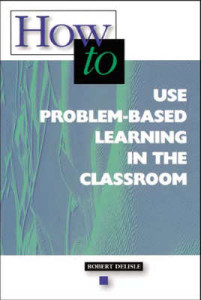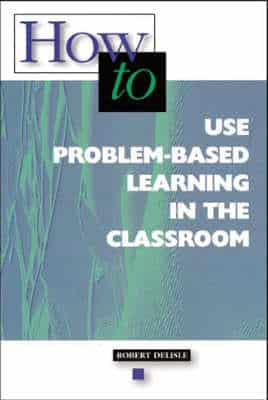Book: How to Use Problem-Based Learning in the Classroom
Author: Robert Delisle
Publisher: ASCD, 1997
[fusion_builder_container hundred_percent=”yes” overflow=”visible”][fusion_builder_row][fusion_builder_column type=”1_1″ background_position=”left top” background_color=”” border_size=”” border_color=”” border_style=”solid” spacing=”yes” background_image=”” background_repeat=”no-repeat” padding=”” margin_top=”0px” margin_bottom=”0px” class=”” id=”” animation_type=”” animation_speed=”0.3″ animation_direction=”left” hide_on_mobile=”no” center_content=”no” min_height=”none”]
My classroom is an active room full of creative fourth graders. I spend the first month teaching them to think independently and problem solve. This is not the space to come and be fed information; this is the space to come and be an interactive part of the learning process. I often have them create projects to demonstrate their learning. I have heard about project-based learning and done some Google surfing about this subject. In May I decided to pick up a book and figure out just how this would look in my classroom.
How to Use Problem-Based Learning in the Classroom, by Robert Delisle matched my teaching philosophy and style. Mr. Delisle says, “…the questions themselves show that children are thinking…We create meaning as much from efforts to answer our own questions as from what we read or hear.” Here was exactly what had prompted me to pick up this book. My questions about how I could implement project-based teaching in my classroom.
The book chapters take you chronologically through the process of project-based learning. The first two chapters gives some history and background as well as reason to use this process. I like that the author references future chapters for you to gain a better understanding of the process. If you are a sequential person you can read the book from front to back and learn how to use project-based learning in your classroom. You will find examples at the end in various grade levels. If you are a big picture person and want examples sooner, Mr. Delisle gives you the specific chapters to skip to for actual PBL examples. This was often helpful as I read so I could find an example of the process as I was learning about the process.
The next few chapters cover how to begin setting up PBL. The author provides information and examples of the teacher’s role and explains how to develop problems for your classroom. “Teachers still decide what content knowledge, skills, and attitudes a problem should help students develop.” PBL is a tool that can fit into any curriculum or set of standards. Project-based learning supports higher level thinking and differentiated instruction. You can use this to implement Common Core Standards because it is all about synthesizing and analysis with evidence. “The structure is key to the whole PBL process,” states Mr. Delisle and he provides examples, resources, charts and evaluations to start this process successfully in your classroom. Using this book you should be able to create, implement, facilitate a project as well as evaluate students learning and the project you created for project-based learning.
The last few chapters provide examples of real classroom project-based problems. There are examples from third through senior high school. They cover math and science as well as real world and social problems. These examples come from teachers in real classrooms. They have many of the same challenges we all have. Each chapter starts with how the problem was developed, gives examples of setting up the structure, and gives details of how the process was implemented. The end of each example gives you questions to consider before starting a project. I felt the author provided many tools and resources to help teachers think through this entire process to increase your chances of success when your first implement PBL.
My school year is starting and I have a million things on my mind. It is easy to slip back into old habits and use lessons that have already proven success. I am challenging myself to pick a small project and use PBL with my fourth-grade class this year. I have confidence from reading How to Use Problem-Based Learning in the Classroom. I know I will make mistakes and it will be a learning process, but it will push me and therefore bring greater learning to my students. If you are interested in doing the same thing in your classroom pick up a copy of How to Use Problem-Based Learning in the Classroom and let us know what project you used.
—
Disclaimer: This book was the possession of the reviewer. Neither The Educator’s Room nor the reviewer received any compensation for this review. The opinions contained in this review are those of the reviewer alone and were written free of any obligation or agreement with the publisher. If you have any questions regarding book reviews, see our full disclaimer or contact The Educator’s Room Book Review Editor.[/fusion_builder_column][/fusion_builder_row][/fusion_builder_container]




